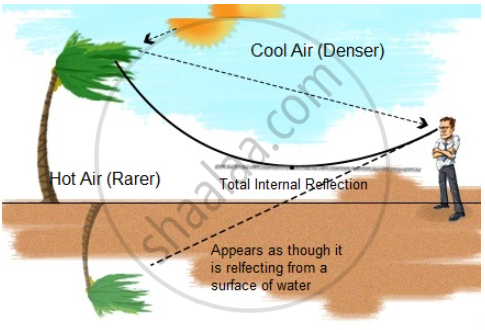Advertisements
Advertisements
Question
The phenomena involved in the reflection of radiowaves by ionosphere is similar to ______.
Options
reflection of light by a plane mirror.
total internal reflection of light in air during a mirage.
dispersion of light by water molecules during the formation of a rainbow.
scattering of light by the particles of air.
Solution
The phenomena involved in the reflection of radiowaves by ionosphere is similar to total internal reflection of light in air during a mirage.
Explanation:
Radio waves are reflected by a layer of the atmosphere called the Ionosphere, so they can reach distant parts of the Earth. The reflection of radio waves by ionosphere is due to total internal reflection. It is the same as total internal reflection of light in the air during a mirage, i.e., angle of incidence is greater than critical angle.
Important point: The ionized part of the Earth’s atmosphere is known as the ionosphere. Ultraviolet light from the sun collides with atoms in this region knocking electrons loose. The creates ions or atoms with missing electrons. This is what gives the Ionosphere its name- and it is the free electrons that cause the reflection and absorption of ratio waves.

APPEARS IN
RELATED QUESTIONS
The diagram below shows a point source P inside a water container. Four rays A, B, C, D starting from the source P are shown up to the water surface

1) Show in the diagram the path of these rays after striking the water surface.
The Critical Angle for the water-air surface is 48°.
2) Name the phenomenon which the rays B and D exhibit.
Name the factors affecting the critical angle for the pair of media.
How does a ray of light bend when it travels from denser to rarer medium.
A ray of light incident at an angle of incidence ‘i’ passes through an equilateral glass prism such that the refracted ray inside the prism is parallel to its base and emerges from the prism at an angle of emergence ‘e’.
What can you say about the value of the angle of deviation in such a situation?
State one factor on which a critical angle for a given pair of media depends. The critical angle for the glass-air interface is 45° for the yellow light. Will it be equal to, less than or greater than 45° for (i) red light, (ii) blue light?
Complete the following diagram to show the path of the ray of a single colour in the diagram as if enters in and emerges out of the prism. Mark the angles wherever necessary. (Critical angle for glass = 42°).

Answer the following question.
Under what conditions are total internal reflection possible? Explain it with a suitable example.
Answer the following question.
Describe the construction and working of an optical fibre.
The angle of incidence at which the angle of refraction is Q£ is called the critical angle.
